
Korean art
Encyclopedia
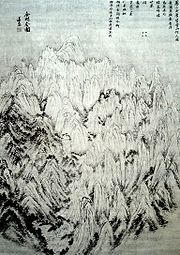
Art
Art is the product or process of deliberately arranging items in a way that influences and affects one or more of the senses, emotions, and intellect....
originating or practiced in Korea
Korea
Korea ) is an East Asian geographic region that is currently divided into two separate sovereign states — North Korea and South Korea. Located on the Korean Peninsula, Korea is bordered by the People's Republic of China to the northwest, Russia to the northeast, and is separated from Japan to the...
or by Korean
Korean people
The Korean people are an ethnic group originating in the Korean peninsula and Manchuria. Koreans are one of the most ethnically and linguistically homogeneous groups in the world.-Names:...
artists, from ancient times to today. Korea is noted for its artistic traditions in pottery, music, calligraphy, and other genres, often marked by the use of bold color, natural forms, and surface decoration.
Introduction
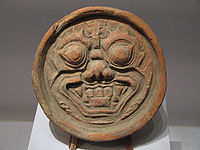
Stone Age
The Stone Age is a broad prehistoric period, lasting about 2.5 million years , during which humans and their predecessor species in the genus Homo, as well as the earlier partly contemporary genera Australopithecus and Paranthropus, widely used exclusively stone as their hard material in the...
works dating from 3000 BCE. These mainly consist of votive sculptures
Votive offering
A votive deposit or votive offering is one or more objects displayed or deposited, without the intention of recovery or use, in a sacred place for broadly religious purposes. Such items are a feature of modern and ancient societies and are generally made in order to gain favor with supernatural...
, although petroglyph
Petroglyph
Petroglyphs are pictogram and logogram images created by removing part of a rock surface by incising, picking, carving, and abrading. Outside North America, scholars often use terms such as "carving", "engraving", or other descriptions of the technique to refer to such images...
s have also been recently rediscovered.
This early period was followed by the art styles of various Korean kingdoms and dynasties. Korean artists sometimes modified Chinese traditions
Chinese art
Chinese art is visual art that, whether ancient or modern, originated in or is practiced in China or by Chinese artists or performers. Early so-called "stone age art" dates back to 10,000 BC, mostly consisting of simple pottery and sculptures. This early period was followed by a series of art...
with a native preference for simple elegance, purity of nature and spontaneity.
The Goryeo
Goryeo
The Goryeo Dynasty or Koryŏ was a Korean dynasty established in 918 by Emperor Taejo. Korea gets its name from this kingdom which came to be pronounced Korea. It united the Later Three Kingdoms in 936 and ruled most of the Korean peninsula until it was removed by the Joseon dynasty in 1392...
Dynasty (918-1392) was one of the most prolific periods for artists in many disciplines, especially in pottery.
The Korean art market is concentrated in the Insadong
Insadong
Insadong is a dong, or neighborhood of the Jongno-gu district of the South Korean city of Seoul. The main street is Insadong-gil, which is connected to a multitude of alleys that lead deeper into the district...
district of Seoul
Seoul
Seoul , officially the Seoul Special City, is the capital and largest metropolis of South Korea. A megacity with a population of over 10 million, it is the largest city proper in the OECD developed world...
where over 50 small galleries exhibit and there are occasional fine arts auctions. Galleries are co-operatively run, small and often with curated and finely designed exhibits. In every town there are smaller regional galleries, with local artists showing in traditional and contemporary media. Art galleries usually have a mix of media. Attempts at bringing Western conceptual art into the foreground have usually had their best success outside of Korea in New York
New York
New York is a state in the Northeastern region of the United States. It is the nation's third most populous state. New York is bordered by New Jersey and Pennsylvania to the south, and by Connecticut, Massachusetts and Vermont to the east...
, San Francisco, London
London
London is the capital city of :England and the :United Kingdom, the largest metropolitan area in the United Kingdom, and the largest urban zone in the European Union by most measures. Located on the River Thames, London has been a major settlement for two millennia, its history going back to its...
and Paris
Paris
Paris is the capital and largest city in France, situated on the river Seine, in northern France, at the heart of the Île-de-France region...
.
Introduction
Professionals have begun to acknowledge and sort through Korea’s own unique art culture and important role in not only transmitting Chinese culture but also assimilating it and creating a unique culture of its own. "An art given birth to and developed by a nation is its own art." says one scholar.Neolithic art
Humans have occupied the Korean PeninsulaKorean Peninsula
The Korean Peninsula is a peninsula in East Asia. It extends southwards for about 684 miles from continental Asia into the Pacific Ocean and is surrounded by the Sea of Japan to the south, and the Yellow Sea to the west, the Korea Strait connecting the first two bodies of water.Until the end of...
since at least 700,000 BCE. Pottery dated to approximately 7,000 BCE has been found. This pottery was made from clay and fired over open or semi-open pits at temperatures around 700 degrees Celsius. http://www.metmuseum.org/toah/ht/02/eak/ht02eak.htm.
The earliest pottery style, dated to circa 7,000 BCE, were flat-bottomed wares (yunggi-mun) were decorated with relief designs, raised horizontal lines and other impressions. http://0-www.search.eb.com.library.uor.edu/eb/article-74351.
Jeulmun-type pottery, is typically cone-bottomed and incised with a comb-pattern appearing circa 6,000 BCE in the archaeological record. This type of pottery is similar to Siberian styles. http://0-www.search.eb.com.library.uor.edu/eb/article-74351.
Mumun-type pottery emerged approximately 2000 BCE and is characterized as large, undecorated pottery, mostly used for cooking and storage.
Bronze Age art
Between 2000 BCE and 300 BCE bronze items began to be imported and made in Korea. By the seventh century BCE, an indigenous bronze culture was established in Korea as evidenced by Korean bronze having a unique percentage of zinc. http://www.metmuseum.org/toah/ht/04/eak/ht04eak.htm. Items manufactured during this time were weapons such as swords, daggers, and spearheads. Also, ritual items such as mirrors, bells, and rattles were made. These items were buried in dolmens with the cultural elite. Additionally, iron-rich red pots began to be created around circa 6th century. Comma-shaped beads, usually made from nephrite, known as kokkok have also been found in dolmen burials. Kokkok may be carved to imitate bear claws. Another Siberian influence can be seen in rock drawings of animals that display a “life line” in the X-ray style of Siberian art. http://0-www.search.eb.com.library.uor.edu/eb/article-74351.Iron Age art
The Iron Age began in Korea around 300 BCE. Korean iron was highly valued in the Chinese commanderies and in Japan. http://www.metmuseum.org/toah/ht/04/eak/ht04eak.htm. Korean pottery advanced with the introduction of the potters wheel and climbing kiln firing.Three Kingdoms art
This period began circa 57 BCE to 668 CE. Three Korean kingdoms, GoguryeoGoguryeo
Goguryeo or Koguryŏ was an ancient Korean kingdom located in present day northern and central parts of the Korean Peninsula, southern Manchuria, and southern Russian Maritime province....
, Baekje
Baekje
Baekje or Paekche was a kingdom located in southwest Korea. It was one of the Three Kingdoms of Korea, together with Goguryeo and Silla....
, and Silla
Silla
Silla was one of the Three Kingdoms of Korea, and one of the longest sustained dynasties in...
vied for control over the peninsula.
Goguryeo
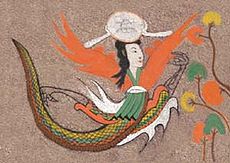
Manchuria
Manchuria is a historical name given to a large geographic region in northeast Asia. Depending on the definition of its extent, Manchuria usually falls entirely within the People's Republic of China, or is sometimes divided between China and Russia. The region is commonly referred to as Northeast...
and the northern half of Korea, closest to the northern Chinese states like the Northern Wei
Northern Wei
The Northern Wei Dynasty , also known as the Tuoba Wei , Later Wei , or Yuan Wei , was a dynasty which ruled northern China from 386 to 534 . It has been described as "part of an era of political turbulence and intense social and cultural change"...
. Buddhism inspired the Goguryeo kings to begin commission art and architecture dedicated to the Buddha. A notable aspect of Goguryeo art are tomb murals that vividly depict everyday aspects of life in the ancient kingdom as well as its culture. UNESCO
UNESCO
The United Nations Educational, Scientific and Cultural Organization is a specialized agency of the United Nations...
designated the Complex of Goguryeo Tombs
Complex of Goguryeo Tombs
The Complex of Goguryeo Tombs lie in North Korea. In July 2004, they became the first UNESCO World Heritage site in the country. The site consists of 30 individual tombs from the later Goguryeo kingdom, one of Three Kingdoms of Korea, located in the cities of P'yŏngyang and Namp'o...
and as a World Heritage Site
World Heritage Site
A UNESCO World Heritage Site is a place that is listed by the UNESCO as of special cultural or physical significance...
because Goguryeo painting was influential in East Asia, including Japan, an example being the wall murals of Horyu-ji
Hōryū-ji
is a Buddhist temple in Ikaruga, Nara Prefecture, Japan. Its full name is Hōryū Gakumonji , or Learning Temple of the Flourishing Law, the complex serving as seminary and monastery both....
which was influenced by Goguryeo. Mural painting also spread to the other two kingdoms. The murals portrayed Buddhist themes and provide valuable clues about kingdom such as architecture and clothing. These murals were also the very beginnings of Korean landscape paintings and portraiture. However, the treasures of the tombs were easily accessible and looted leaving very little physical artifacts of the kingdom.
Baekje
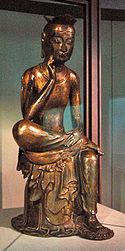
Liang
Liang may refer to:*Liang , a Chinese surname common in Taiwan and southern China.*Liang , one of the states in China of the Spring and Autumn period ....
. Baekje was also one of the kingdoms to introduce a significant Korean influence into the art of Japan during this time period.
Baekje Buddhist sculpture is characterized by its naturalness, warmness, and harmonious proportions exhibits a unique Korean style. Another example of Korean influence is the use of the distinctive "Baekje smile
Baekje smile
The Baekje smile is a term art historians use to refer to the common smile motif found in Baekje sculpture and bas-relief. Baekje figures express a unique smile that has been described as both enigmatic and subtle...
", a mysterious and archaic smile that is characteristic of many Baekje statutes. While there are no surviving examples of wooden architecture, the Mireuksa
Mireuksa
Mireuksa was the largest Buddhist temple in the ancient Korean kingdom of Baekje. The temple was established in 602, by King Mu and is located 36.012083 N, 127.031028 E. This place depends nowadays from Iksan City . The site was excavated in 1980, disclosing many hitherto unknown facts about...
site holds the foundation stones of a destroyed temple and two surviving granite pagodas that show what Baekje architecture may have looked. An example of Baekje architecture may be gleaned from Horyu-ji
Hōryū-ji
is a Buddhist temple in Ikaruga, Nara Prefecture, Japan. Its full name is Hōryū Gakumonji , or Learning Temple of the Flourishing Law, the complex serving as seminary and monastery both....
temple because Baekje architects and craftsmen helped design and construct the original temple.
The tomb of King Muryeong held a treasure trove of artifacts not looted by grave robbers. Among the items were flame-like gold pins, gilt-bronze shoes, gold girdles (a symbol of royalty), and swords with gold hilts with dragons and phoenixes.
Silla
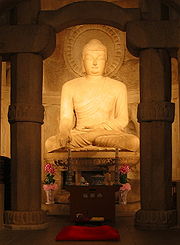
The Silla Kingdom tombs were mostly inaccessible and so many examples of Korean art come from this kingdom. The Silla craftsman were famed for their gold-crafting ability which have similarities to Etruscan
Etruscan civilization
Etruscan civilization is the modern English name given to a civilization of ancient Italy in the area corresponding roughly to Tuscany. The ancient Romans called its creators the Tusci or Etrusci...
and Greek
Ancient Greece
Ancient Greece is a civilization belonging to a period of Greek history that lasted from the Archaic period of the 8th to 6th centuries BC to the end of antiquity. Immediately following this period was the beginning of the Early Middle Ages and the Byzantine era. Included in Ancient Greece is the...
techniques, as exampled by gold earrings and crowns. Because of Silla gold artifacts bearing similarities to European techniques along with glass and beads depicting blue-eyed people found in royal tombs, many believe that the Silk Road
Silk Road
The Silk Road or Silk Route refers to a historical network of interlinking trade routes across the Afro-Eurasian landmass that connected East, South, and Western Asia with the Mediterranean and European world, as well as parts of North and East Africa...
went all the way to Korea. Most notable objects of Silla art are its gold crowns that are made from pure gold and have tree and antler-like adornments that suggest a Scythe-Siberian and Korean shamanistic tradition. http://www.metmuseum.org/toah/hd/sila/hd_sila.htm
Gaya
The Gaya confederacy was a group of city-states that did not consolidate into a centralized kingdom. It shared many similarities in its art, such as crowns with tree-like protrusions which are seen in Baekje and Silla. Many of the artifacts unearthed in Gaya tumuli are artifacts related to horses, such as stirrups, saddles,and horse armor.Unified Silla art
Unified Silla was a time of great artistic output in Korea, especially in Buddhist art. Examples include the SeokguramSeokguram
The Seokguram Grotto is a hermitage and part of the Bulguksa temple complex. It lies four kilometers east of the temple on Mt. Tohamsan, in Gyeongju, South Korea. It is classified as National Treasure No. 24 by the South Korean government and is located at 994, Jinhyeon-dong, Gyeongju-si,...
grotto and the Bulguksa
Bulguksa
Bulguksa is a head temple of the Jogye Order of Korean Buddhism in the North Gyeongsang province in South Korea. It is home to seven National treasures of South Korea, including Dabotap and Seokgatap stone pagodas, Cheongun-gyo , and two gilt-bronze statues of Buddha. The temple is classified as...
temple. Two pagodas on the ground, the Seokgatap and Dabotap are also unique examples of Silla masonry and artistry. Craftsmen also created massive temple bells, reliquaries, and statutes. The capital city of Unified Silla was nicknamed the “city of gold” because of use of gold in many objects of art.
Goryeo Dynasty art
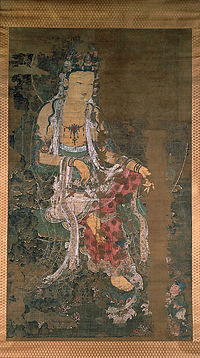
Celadon
Celadon is a term for ceramics denoting both a type of glaze and a ware of a specific color, also called celadon. This type of ware was invented in ancient China, such as in the Zhejiang province...
pottery which was produced from circa 1050 CE to 1250 CE. While celadon originated in China, Korean potters created their own unique style of pottery that was so valued that the Chinese considered it “first under heaven” and one of the “twelve best things in the world.”
The Korean celadon had a unique glaze known as “king-fisher” color, an iron based blue-green glaze created by reducing oxygen in the kiln. Korean celadon displayed organic shapes and free-flowing style, such as pieces that were made to look like fish, melons, and other animals. Koreans invented an inlaid technique known as sanggam, where potters would engrave semi-dried pottery with designs and place materials within the decorations with black or white clay.
Joseon Dynasty art
The influence of Confucianism superseded that of Buddhism in this period, however Buddhist elements remained and it is not true that Buddhist art declined, it continued, and was encouraged but not by the imperial centres of art, or the accepted taste of the Joseon Dynasty publicly; however in private homes, and indeed in the summer palaces of the Joseon Dynasty kings, the simplicity of Buddhist art was given great appreciation - but it was not seen as citified art.While the Joseon Dynasty began under military auspices, Goreyo styles were let to evolve, and Buddhist iconography (bamboo, orchid, plum and chrysanthemum; and the familiar knotted goodluck symbols) were still a part of genre paintings. Neither colours nor forms had any real change, and rulers stood aside from edicts on art. Ming ideals and imported techniques continued in early dynasty idealized works.
Mid-dynasty painting styles moved towards increased realism. A national painting style of landscapes called "true view" began - moving from the traditional Chinese style of idealized general landscapes to particular locations exactly rendered. While not photographic, the style was academic enough to become established and supported as a standardized style in Korean painting.
The mid to late Joseon
Joseon Dynasty
Joseon , was a Korean state founded by Taejo Yi Seong-gye that lasted for approximately five centuries. It was founded in the aftermath of the overthrow of the Goryeo at what is today the city of Kaesong. Early on, Korea was retitled and the capital was relocated to modern-day Seoul...
dynasty is considered the golden age of Korean painting. It coincides with the shock of the collapse of Ming dynasty
Ming Dynasty
The Ming Dynasty, also Empire of the Great Ming, was the ruling dynasty of China from 1368 to 1644, following the collapse of the Mongol-led Yuan Dynasty. The Ming, "one of the greatest eras of orderly government and social stability in human history", was the last dynasty in China ruled by ethnic...
links with the Manchu emperors accession in China, and the forcing of Korean artists to build new artistic models based on nationalism and an inner search for particular Korean subjects. At this time China ceased to have pre-eminent influence, Korean art took its own course, and became increasingly distinctive.
Visual arts
Korean art is characterized by transitions in the main religions at the time: early Korean shamanist art, then Korean Buddhist art and Korean Confucian artKorean Confucian art
Korean Confucian art took strong hold with the Yi generals who set in place the Joseon dynasty which distinguished itself in many ways by promoting Confucian thought as the basis for a new national vision...
, through the various forms of Western arts in the 20th century.
Art works in metal, jade
Jade
Jade is an ornamental stone.The term jade is applied to two different metamorphic rocks that are made up of different silicate minerals:...
, bamboo
Bamboo
Bamboo is a group of perennial evergreens in the true grass family Poaceae, subfamily Bambusoideae, tribe Bambuseae. Giant bamboos are the largest members of the grass family....
and textiles have had a limited resurgence. The South Korean government has tried to encourage the maintenance of cultural continuity by awards, and by scholarships for younger students in rarer Korean art forms.
Calligraphy and printing

Korean calligraphy
Korean calligraphy is a variant of Chinese calligraphy, formerly applied to Chinese characters to transcribe Korean speech. It later also applied to the Korean alphabet . Hangul introduces the circle stroke...
is seen as an art where brush-strokes reveal the artist's personality enhancing the subject matter that is painted. This art form represents the apogee of Korean Confucian art
Confucian art
Confucian art is art inspired by the writings of Confucius, and Confucian teachings. Confucian art originated in China, then spread westwards on the Silk road, southward down to southern China and then onto Southeast Asia, and eastwards through northern China on to Japan and Korea. It still...
.
Korean fabric arts
Korean fabric arts
Korean fabric arts have a long history, and only now are being seen as worth archaeological study, preservation, and research work. The traditional arts of Korean embroidery, Korean knots, Korean clothing and the rarer arts of Korean blinds weaving and Korean paper clothing are worthy of study.This...
have a long history, and include Korean embroidery
Korean embroidery
The techniques and artifacts created by Korean embroidery has a long history, but there is the most evidence from the Joseon Dynasty, after the 14th century in Korea...
used in costumes and screenwork; Korean knots
Korean knots
Traditional knots in Korea has been used for various purposes like hunting tools, decoration, clothes and so on throughout Korean history. Its usage was first only limited to the royal families and later spread to common people. Korean knot is different from Chinese knots in history and form...
as best represented in the work of Choe Eun-sun, used in costumes and as wall-decorations; and lesser known weaving skills as indicated below in rarer arts. There is no real tradition of Korean carpets or rugs, although saddle blankets and saddle covers were made from naturally dyed wool, and are extremely rare. Imperial dragon carpets, tiger rugs for judges or magistrates or generals, and smaller chair-covers were imported from China and are traditionally in either yellow or red. Few if any imperial carpets remain. Village rug weavers do not exist.
Korean paper art includes all manner of hand-made paper (hanji), used for architectural purposes (window screens, floor covering), for printing, artwork, and the Korean folded arts (paper fans, paper figures), and as well Korean paper clothing which has an annual fashion show in Jeonju
Jeonju
Jeonju is a city in South Korea, and the capital of Jeollabuk-do, or North Jeolla Province. It is an important tourist center famous for Korean food, historic buildings, sports activities and innovative festivals.- History :...
city attracting world attention.
In the 1960s Korean paper made from mulberry roots was discovered when the Pulguksa (temple) complex in Gyeongju
Gyeongju
Gyeongju is a coastal city in the far southeastern corner of North Gyeongsang province in South Korea. It is the second largest city by area in the province after Andong, covering with a population of 269,343 people according to the 2008 census. Gyeongju is southeast of Seoul, and east of the...
was remodelled. The date on the Buddhist documents converts to a western calendar date of 751, and indicated that indeed the oft quoted claim that Korean paper can last a thousand years was proved irrevocably. However after repeated invasions, very little early Korean paper art exists. Contemporary paper artists are very active.
Painting
Contemporary Korean paintingKorean painting
Korean painting includes paintings made in Korea or by overseas Koreans on all surfaces. It includes art as old as the petroglyphs through post-modern conceptual art using transient forms of light...
demands an understanding of Korean ceramics and Korean pottery
Korean pottery
Korean ceramic history begins with the oldest earthenware from around 8000 BC.-Three Kingdoms pottery:-Goryeo Dynasty porcelain:The Goryeo Dynasty achieved the unification of the Later Three Kingdoms under King Taejo...
as the glazes used in these works and the textures of the glazes make Korean art more in the tradition of ceramic art, than of western painterly traditions, even if the subjects appear to be of western origin. Brush-strokes as well are far more important than they are to the western artist; paintings are judged on brush-strokes more often than pure technique.
The contemporary artist Suh Yongsun
Suh Yongsun
Suh Yongsun, also Yong Sun Suh or Seo Young-Sun , is a Korean painter and sculptor. In his art he mainly portrays human existence.Suh lives and has his main studio in Gyeonggido near Seoul.- Life :...
, who is highly appreciated and was elected "Korea's artist of the year 2009", makes paintings with heavy brushstrokes and shows topics like both Korean history and urban scenes especially of Western cities like New York
New York
New York is a state in the Northeastern region of the United States. It is the nation's third most populous state. New York is bordered by New Jersey and Pennsylvania to the south, and by Connecticut, Massachusetts and Vermont to the east...
and Berlin
Berlin
Berlin is the capital city of Germany and is one of the 16 states of Germany. With a population of 3.45 million people, Berlin is Germany's largest city. It is the second most populous city proper and the seventh most populous urban area in the European Union...
. His artwork is a good example for the combination of Korean and Western subjects and painting styles.
Other Korean artists combining modern Western and Korean painting traditions are i.e. Junggeun Oh
Junggeun Oh
Junggeun Oh, also Oh Jung Geun is a Korean painter. Living in Berlin since 2004 he paints artworks of a modern minimalism mixing abstraction with realism. The artist is represented by galerie son, Berlin.- Life :Junggeun Oh studied Fine Arts at Seoul National University in South Korea...
and Tschoon Su Kim
Tschoon Su Kim
Tschoon Su Kim, also Kim, Tschoon-Su , is a Korean painter. He is a professor at Seoul National University and paints only in Blue.- Life :...
.
While there have been only rare studies on Korean aesthetics, a useful place to begin for understanding how Korean art developed an aesthetic is in Korean philosophy
Korean philosophy
Korean philosophy goes back more than two thousand years. Traditional Korean philosophy focused on a totality of world view. The emotional content of Shamanism, and the unpredictable, and some aspects of Neo-Confucianism were both integrated into it....
, and related articles on Korean Buddhism
Korean Buddhism
Korean Buddhism is distinguished from other forms of Buddhism by its attempt to resolve what it sees as inconsistencies in Mahayana Buddhism. Early Korean monks believed that the traditions they received from foreign countries were internally inconsistent. To address this, they developed a new...
, and Korean Confucianism
Korean Confucianism
Korean Confucianism is the form of Confucianism developed in Korea. One of the most substantial influences in Korean intellectual history was the introduction of Confucian thought as part of the cultural influence from China...
.
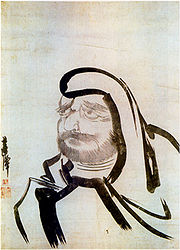
North Korea
In the north, changing political systems from CommunismCommunism
Communism is a social, political and economic ideology that aims at the establishment of a classless, moneyless, revolutionary and stateless socialist society structured upon common ownership of the means of production...
merging with the old yangban
Yangban
The yangban were part of the traditional ruling class or nobles of dynastic Korea during the Joseon Dynasty. The yangban were either landed or unlanded aristocracy who comprised the Korean Confucian idea of a "scholarly official." In reality, they were basically administrators and bureaucrats who...
class of Korean nationalistic leaders have brought out a different kind of visual arts that again is quite distinctive from the common socialist art styles. This is so particularly in the patriotic films that dominated that culture from 1949 to 1994, and the reawakened architecture, calligraphy, fabric work and neo-traditional painting, that has occurred from 1994 to date.
The impact was greatest on revolutionary posters, lithography and multiples, dramatic and documentary film, realistic painting, grand architecture, and least in areas of domestic pottery, ceramics, exportable needlework, and the visual crafts. Sports art and politically charged revolutionary posters have been the most sophisticated and internationally collectible by auction houses and specialty collectors. North Korean painters who escaped to the United States in the late 1950s include the Fwhang sisters. Duk Soon Fwhang and Chung Soon Fwhang O'Dwyer avoid overtly political statements in favor of tempestuous landscapes, bridging Western and Far Eastern painting techniques.
Ceramics and sculpture
Korean potteryKorean pottery
Korean ceramic history begins with the oldest earthenware from around 8000 BC.-Three Kingdoms pottery:-Goryeo Dynasty porcelain:The Goryeo Dynasty achieved the unification of the Later Three Kingdoms under King Taejo...
is the most famous and senior art in Korea, it is closely tied to Korean ceramics which represents tile work, large scale ceramic murals, and architectural elements.
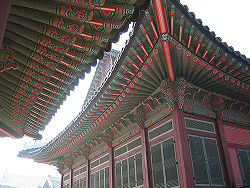
- Korean bronze art, as represented in the work of Kim Jong-dae, master of yundo or bronze mirror casting; and Yi Bong-ju, who works in hammered bronze metalware.
- Korean silver art, as represented in the work of Kim Cheol-ju in circular silver containers.
- Korean jade carvingKorean jade carvingThe tradition of Korean jade carving dates back to neolithic finds along the Namgang river basin in Gyeongju. Jade rings and accessories were worn by the higher classes of society, especially women, from the three kingdoms period and reached their peak in the Joseon dynasty, the golden age of...
, as represented in the work of Master Jang-Ju won typically in Joseon Dynasty imperial style, with complex jade knotwork, Buddhist motifs, and Korean shamanistic grotesques. - Korean grass weaving as represented in the work of Master Yi Sang-jae, in his legendary wancho weaving containers.
- Korean bamboo pyrography, as represented in the work of Kim Gi-chan in this unique artwork involved with burning patterns and art on circular bamboo containers.
- Korean bamboo strip work, as represented in the work of Seo Han-gyu (chaesang weaving), and Yi Gi-dong (bamboo fans).
- Korean ox-horn inlaying, as represented in the work of Yi Jae-man in his small storage box, and commissioned gift furniture.
- Korean blinds weaving, as represented in the work of seventh generation master, Jo Dae-yong, and descended from Jo Rak-sin, who created his first masterworks for King Cheoljong; and through Jo Seong-yun, and Jo Jae-gyu. Winners of Joseon Craft Contests. The artwork known as Tongyeong blinds has gained more recognition with the appointment of Jo Dae-yong as Master Craftsman of Bamboo Blinds weaving *Yeomjang) by the Korean government, and his artworks as "Important Intangible Cultural Property No. 114", with Jo at age 51 becoming the youngest 'human cultural property' in the republic.
- Korean wood sculpture, as represented in the work of Park Chan-soo and is a subdivision of Korean sculptureKorean sculptureKorean sculpture has a long history, and was exported abroad, primarily during the Baekje period to Japan, where Korean Buddhist sculptures from the seventh century still exist. In the main Korean sculptures were of wood, then stone, and then ceramics, with votive sculptures being of the greatest...
.
Architecture and interior design
There is a long tradition of Korean gardens, often linked with palaces.Patterns often have their origins in early ideographs. Geometric patterns and patterns of plant, animal and nature motifs are the four most basic patterns. Geometric patterns include triangles, squares, diamonds, zigzags, latticework
Latticework
Latticework is a framework consisting of a criss-crossed pattern of strips of building material, typically wood or metal. The design is created by crossing the strips to form a network...
, frets, spirals sawteeth, circles, ovals and concentric circles. Stone Age rock carvings feature animal designs in order to relate to food-gathering activities. These patterns are found doors of temples and shrines, clothes, furniture and daily objects such as fans and spoons.
Performing arts
In the performing arts, Korean storytelling is done in both ritualistic shamanistic ways, in the songs of yangbanYangban
The yangban were part of the traditional ruling class or nobles of dynastic Korea during the Joseon Dynasty. The yangban were either landed or unlanded aristocracy who comprised the Korean Confucian idea of a "scholarly official." In reality, they were basically administrators and bureaucrats who...
scholars, and the cross-overs between the visual arts and the performing arts which are more intense and fluid than in the West.
Depicted on petroglyphs and in pottery shards, as well as wall-paintings in tombs, the various performing arts nearly always incorporated Korean masks, costumes with Korean knots
Korean knots
Traditional knots in Korea has been used for various purposes like hunting tools, decoration, clothes and so on throughout Korean history. Its usage was first only limited to the royal families and later spread to common people. Korean knot is different from Chinese knots in history and form...
, Korean embroidery
Korean embroidery
The techniques and artifacts created by Korean embroidery has a long history, but there is the most evidence from the Joseon Dynasty, after the 14th century in Korea...
, and a dense overlay of art in combination with other arts.
Some specific dances are considered important cultural heritage pieces of art. The performing arts have always been linked to the fabric arts: not just in costumery, but in woven screens behind the plays, ornaments woven or embroidered or knotted to indicate rank, position, or as shamanistic charms; and in other forms to be indicated.
Historically the division of the performing arts is between arts done almost exclusively by women in costume, danceworks; and those done exclusively by men in costume, storytelling. And those done as a group by both sexes with women's numbers in performances reduced as time goes on as it became reputable for men to function as public entertainers.
Tea ceremony
The Korean tea ceremonyKorean tea ceremony
The Korean tea ceremony or darye is a traditional form of tea ceremony practiced in Korea. Darye literally refers to "etiquette for tea" or "day tea rite" and has been kept among Korean people for a few thousand years...
is held in a Korean tea house with characteristic architecture
Architecture
Architecture is both the process and product of planning, designing and construction. Architectural works, in the material form of buildings, are often perceived as cultural and political symbols and as works of art...
, often within Korean gardens
Korean gardens
A Korean garden is natural, simple, and unforced, they are less formal and seek to merge with the natural world. They have a history that goes back more than two thousand years, but is little known in the west...
and served in a way with ritualized conversation, formal poetry on wall-scrolls, and with Korean pottery
Korean pottery
Korean ceramic history begins with the oldest earthenware from around 8000 BC.-Three Kingdoms pottery:-Goryeo Dynasty porcelain:The Goryeo Dynasty achieved the unification of the Later Three Kingdoms under King Taejo...
and traditional Korean costumes, the environment itself is a series of naturally flowing events that provide a cultural and artistic experience.
Musical arts and theatre
The skill of contemporary Korean performing artists, who have had great recognition abroad, particularly in stringed instruments and as symphony directors, or operatic sopranos and mezzos, takes part in a long musical history.Korean music
Korean music
Traditional Korean music includes both the folk, vocal, religious and ritual music styles of the Korean people. Korean music, along with arts, painting, and sculpture has been practiced since prehistoric times....
in contemporary times is generally divided into the same audiences as the west: with the same kind of audiences for music based on age, and city (classical, pop, techno, house, hip-hop, jazz; traditional) and provincial divisions (folk, country, traditional, classical, rock). World music influences are very strong provincially, with traditional musical instruments once more gaining ground. Competition with China for tourists has forced a much larger attention to traditional Korean musical forms in order to differentiate itself from the west, and east.
The new Seoul Opera house, which will be the anchor for Korean opera has just been given the go-ahead, is set for a $300 million dollar home on an island on the Han river. Korean opera and an entirely redeveloped western opera season, and opera school, to compete with the Beijing opera house, and Japan's historical centre for western operas in the far east is the present focus.
Korean court music
Korean court music
Korean court music refers to the music developed in the Joseon Dynasty . Very little is known about the court music of earlier Korean kingdoms and dynasties.It was partly modeled on the court music of China, known as yayue...
has a history going back to the Silla
Silla
Silla was one of the Three Kingdoms of Korea, and one of the longest sustained dynasties in...
where Tang
Tang Dynasty
The Tang Dynasty was an imperial dynasty of China preceded by the Sui Dynasty and followed by the Five Dynasties and Ten Kingdoms Period. It was founded by the Li family, who seized power during the decline and collapse of the Sui Empire...
court music was played; later Song
Song
In music, a song is a composition for voice or voices, performed by singing.A song may be accompanied by musical instruments, or it may be unaccompanied, as in the case of a cappella songs...
dynasty inspired "A-ak" a Korean version played on Chinese instruments within the Joseon
Joseon Dynasty
Joseon , was a Korean state founded by Taejo Yi Seong-gye that lasted for approximately five centuries. It was founded in the aftermath of the overthrow of the Goryeo at what is today the city of Kaesong. Early on, Korea was retitled and the capital was relocated to modern-day Seoul...
era. Recreations of this music are done in Seoul primarily under the auspices of the Korea Foundation and The National Center for Korean Traditional Performing Arts
The National Center for Korean Traditional Performing Arts
National Gugak Center, located in Seoul, South Korea, is the primary institution of learning for Korean traditional music.With a history dating back to the Eumseongseo music institute of the Silla kingdom in the 7th century, The National Center for Korean Traditional Performing Arts was founded...
(NCKTPA).
Court musicians appear in traditional costume, maintain a rigid proper formal posture, and play stringed five-stringed instruments. Teaching by this the "yeak sasang" principles of Confucianism, perfection of tone and acoustic space is put ahead of coarse emotionality. Famous works of court music include: jongmyo jeryeak, designated a UNESCO world cultural heritage, Cheoyongmu, Taepyeongmu, and Sujecheon.
Korean folk music or pansori
Pansori
Pansori is a genre of Korean traditional music. It is a vocal and percussional music performed by one sorikkun and one gosu . The term pansori is derived from pan , and sori .- Overview :...
is the base from which most new music originates being strongly simple and rhythmic.
Korean musicals are a recent innovation, encouraged by the success of Broadway revivals, like Showboat, recent productions such as the musical based on Queen Min have toured globally. There are precedents for popular musical dance-dramas in gamuguk popular in Goryeo times, with some 21st century concert revivals.
Korean stage set design again has a long history and has always drawn inspiration from landscapes, beginning with outdoor theatre, and replicating this by the use of screens within court and temple stagings of rituals and plays. There are few if any books on this potentially interesting area. A rule of thumb has been that the designs have much open space, more two-dimensional space, and subdued tone and colour, and been done by artists to evoke traditional brush painting subjects. Modern plays have tended towards western scenic flats, or minimalist atonality to force a greater attention on the actors. Stage lighting still has to catch up to western standards, and does not reflect a photographer's approach to painting in colour and light, quite surprisingly.
Korean masks are generally used in shamanistic performances that have increasingly been secularized as folkart dramas. At the same time the masks themselves have become tourist artefacts post 1945, and reproduced in large numbers as souvenirs.
Storytelling and comedy
Narrative storytelling, either in poetic dramatic song by yangban scholars, or in rough-housing by physical comedians, is generally a male performance. There is as yet virtually no stand-up comedy in Korea because of cultural restrictions on insult-humour, personal comments, and respect for seniors, despite globally successful Korean comic films which depend on comedy of error, and situations with no apparent easy resolution under tight social restraints.Korean oral history includes narrative myths, legends, folk tales; songs, folksongs, shaman songs and p'ansori; proverbs that expand into short historical tales, riddles, and suspicious words which have their own stories. They have been studied by Cho Dong-Il; Choi In-hak, and Zong In-sop, and published often in editions in English for foreigners, or for primary school teachers.
Dance
Dance is a significant element of traditional Korean culture. Special traditional dances are performed as part of many annual festivals and celebrations (harvest, etc), involving traditional costumes, specific colors, music, songs and special instruments. Some dances are performed by either men only or women only, while others are performed by both. The women usually have their hair pulled back away from the face in a bun, or may be wearing colorful hats. Some variation of the traditional hanbokHanbok
Hanbok or Chosŏn-ot is the traditional Korean dress. It is often characterized by vibrant colors and simple lines without pockets. Although the term literally means "Korean clothing", hanbok today often refers specifically to hanbok of Joseon Dynasty and is worn as semi-formal or formal wear...
is typically worn, or a special costume specific to that dance. In some dances, the women's costumes will have very long sleeves, or trail a long length of fabric, to accentuate graceful arm movements. Outdoor festivals are loud and joyous, and cymbals and drums can prominently be heard. Masks may be worn.
Literature
Notable examples of historical records are very well documented from early times, and as well Korean books with moveable type, often imperial encyclopaedias or historical records, were circulated as early as the 7th century during the Three KingdomsThree Kingdoms of Korea
The Three Kingdoms of Korea refer to the ancient Korean kingdoms of Goguryeo, Baekje and Silla, which dominated the Korean peninsula and parts of Manchuria for much of the 1st millennium...
era from printing wood-blocks; and in the Goryeo
Goryeo
The Goryeo Dynasty or Koryŏ was a Korean dynasty established in 918 by Emperor Taejo. Korea gets its name from this kingdom which came to be pronounced Korea. It united the Later Three Kingdoms in 936 and ruled most of the Korean peninsula until it was removed by the Joseon dynasty in 1392...
era the world's first metal type, and books printed by metal type were produced.
Genres include epics, poetry, religious texts and exigetical commentaries on Buddhist and Confucianist learning; translations of foreign works; plays and court rituals; comedies, tragedies, mixed genres; and various kinds of novels. Korean's weave.
Poetry
Korean poetryKorean poetry
Korean poetry is poetry performed or written in the Korean language or by Korean people. Traditional Korean poetry is often sung in performance. Until the 20th century, much of Korean poetry was written in Hanja and later Hangul.- History :...
began to flourish in the Three Kingdoms period. Collections were repeatedly printed. With the rise of Joseon nationalism, poetry developed increasingly so and reached its apex in the late 18th century. There were attempts at introducing imagist and modern poetry methods in the early 20th century, and in the early republic period, patriotic works were very successful. Lyrical poetry
20th century lyric poetry
In the early years of the twentieth century rhymed lyric poetry, usually expressing the feelings of the poet, was the dominant poetic form in America, Europe and the British colonies. The relevance and acceptability of the lyric in the modern age was, though, called into question by modernism, the...
dominated from the 1970s onwards.
See also
- Culture of KoreaCulture of KoreaThe current political separation of North and South Korea has resulted in divergence in modern Korean cultures; nevertheless, the traditional culture of Korea is historically shared by both states.-Dance:...
- Korean potteryKorean potteryKorean ceramic history begins with the oldest earthenware from around 8000 BC.-Three Kingdoms pottery:-Goryeo Dynasty porcelain:The Goryeo Dynasty achieved the unification of the Later Three Kingdoms under King Taejo...
- Buddhist artBuddhist artBuddhist art originated on the Indian subcontinent following the historical life of Siddhartha Gautama, 6th to 5th century BC, and thereafter evolved by contact with other cultures as it spread throughout Asia and the world....
- Korean Confucian artKorean Confucian artKorean Confucian art took strong hold with the Yi generals who set in place the Joseon dynasty which distinguished itself in many ways by promoting Confucian thought as the basis for a new national vision...
- Korean swordKorean swordFor much of Korea's history, swords were created for an individual user; thus, most Korean swords were different and did not follow a set standard model....
- Eastern art historyEastern art historyThe history of Eastern art includes a vast range of influences from various cultures and religions. Developments in Eastern art historically parallel those in Western art, in general a few centuries earlier...
External links
- Online Gallery introducing North Korean painters
- The Art of Korean Potters
- Overview of Rarer Korean artforms
- Gallery of rarer Korean artforms
- Korean Studies Audio and Slideshow Files
- Cultural Assets of Korea
- Korean Exhibit at CSUN Library
- Korean Art Held in Japan
- Online Collection of Selected Pieces of Modern and Contemporary Korean Art
- The Herbert Offen Research Collection of the Phillips Library at the Peabody Essex Museum

